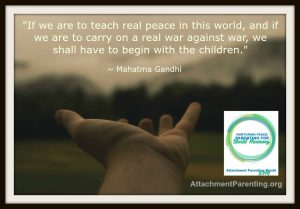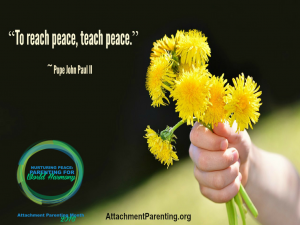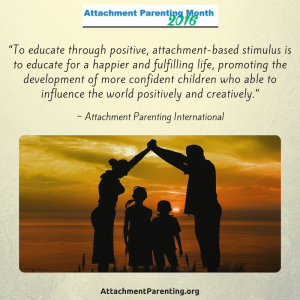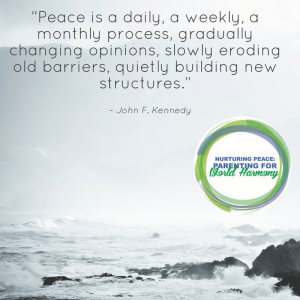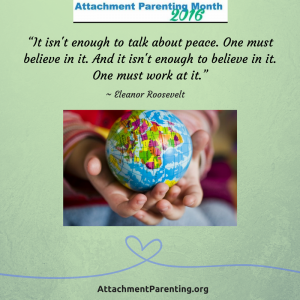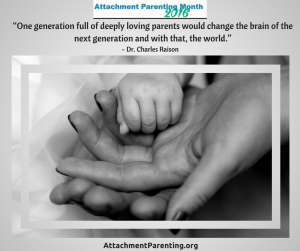Category: Practice Positive Discipline
To reach peace, teach peace
To educate through positive attachment…
Cultivating a peaceful family: 5 effective ways to tend to one’s inner harmony
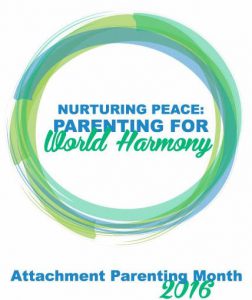 There’s that saying you’ve probably heard — “If Mama ain’t happy, ain’t nobody happy.” I first saw it, framed, in the kitchen of my high school friend and it made me slightly afraid of her mom. It seemed like it had been hung there as a warning.
There’s that saying you’ve probably heard — “If Mama ain’t happy, ain’t nobody happy.” I first saw it, framed, in the kitchen of my high school friend and it made me slightly afraid of her mom. It seemed like it had been hung there as a warning.
But parents, let’s be honest: We wake up a little sleep deprived from a late-night session catching up on a project, and the tension during breakfast is going to be thick.
On such mornings, I recognize this possibility looming in our kitchen when I notice how my daughter is looking at me. Just the other day, I caught that look and said with spatula in hand, “OK, yeah, I admit that I am too tired to be reliably nice this morning. Sorry in advance.”
“Breathe, Mama,” she reminds me, “I won’t fight today when you braid my hair.”
Here’s the thing: Our children are keenly tuned in to us. They know very well how to read the signs that serve as the early warning system indicating the likelihood of an impending mom-meltdown. Over time, they have become skilled at rating the level of threat like rangers adjusting those Smokey the Bear fire danger signs in the national forests: “Today’s Mom-fire threat level is Green.” (Whew, we’re OK.)
Your Brain on Stress
Researchers in the field of neuroscience are making exciting discoveries these days about the ways the body and mind are intimately connected. This gives us more insight into how it is that what we think and what thoughts we rehearse over and over actually change our brains. As our biochemistry is so changed, this has the power to affect the expression of our genes.
These findings also give us insight to why it is that when stress starts generating pressure and heat inside of us, our best intentions get vaporized.
The physiological responses that kept our ancestors safe do not help us in modern situations when we are not required to jump out of the way of a charging animal. What we perceive today as the danger that switches on our stress response is much different. Nonetheless, the nervous system still responds by shutting off the thinking and planning part of the brain — the prefrontal cortex — in order to send blood to the body so we can fight or run away.
But that is not a helpful response when it’s getting late in the morning and someone whines about losing their shoe or the garbage truck is blocking the driveway. While it might sharpen our reflexes so that we can deftly speed through traffic to get the kids to school, it is likely why the road rage happens since the part of our brains that inhibit undignified behavior is offline. (“Mom, you said a bad word to that guy!”)
Stress makes it more likely we will yell at our kids in spite of our best intentions to be the Zen-Mommy who guides her children serenely through the morning routine as if her mind is naturally infused with calming lavender essential oil. No parent wants to be the source of stress or bad times in the family, no matter how much responsibility, worry, or fatigue we are grappling with. But the truth is: When we get triggered, it affects our children. When that happens, we feel regret and add a black mark to our list of our failures.
What if there is a way to naturally achieve resilience to stress and to be easily able to access our inner resources? The good news is, it is not that hard to achieve the Sugar Land Integrated Counseling and Wellness teaches you how to take steps to give your inner life the attention required. Your family life will improve in delicious ways if you do.
We show up to the parenting journey carrying the baggage of our own histories: the fears, traumas, limiting beliefs, self-doubt, and those less-than-elegant, knee-jerk reaction tendencies. When the time comes to settle down, we unpack all that and then go about our business of creating a family.
If physical clutter in the home produces stress, how about all the emotional clutter of past regrets, hurts, sorrows, and traumas that we stuffed into the overfilled drawers of our minds? Imagine what a relief it would be to have the inner spaciousness that would allow us to breathe before we speak, or to listen mindfully so we can perceive the heart of the matter instead of reacting to what triggers us.
Fortunately, there are now several highly effective self-help techniques that are great tools to eliminate the internal clutter and create more emotional freedom and space, including these 5 effective ways to tend to one’s inner harmony for a happier home:
- Meditation — Research is finally catching up to the wisdom traditions that have long known the value of sitting quietly. Owing to the brain’s capacity to form new neural pathways, called neuroplasticity, scientists have found measurable differences in the brains of meditators. Higher brain functioning in the prefrontal cortex is enhanced, cortical tissue is made thicker — that’s really good — and parts of the brain that engender calm also become larger and more active. The good news for busy people is that according to the research, it is better to practice just a little each day versus half an hour every once in a while. Even taking just 1 minute every day to calm your physiology by taking mindful, slow breaths is going to help you. A dedicated meditation practice has the power to help you release burdens and create real calm.
- Emotional Freedom Technique (EFT) and Tapas Acupressure Technique (TAT) — Also known as Meridian Tapping, EFT is a form of counseling intervention. It is a powerful way you can dramatically reduce your suffering quickly. It consists of tapping with your fingers on specific acupuncture points on the head and torso. Research has shown that EFT causes lasting improvements by alleviating trauma physiology. Tapping has even been shown to cause immediate changes to blood chemistry, which is truly remarkable. There are many resources on line to help you learn how to do EFT. TAT also engages the energy system of the body to release strong feelings, negative beliefs, and trauma. Unlike EFT, TAT does not require you to talk about what is bothering you.
- Yoga — It’s not just exercise. According to trauma researcher Bessel Van der Kolk, PhD, when practiced regularly, yoga can profoundly help heal trauma and stress, especially when practiced along with mindfulness meditation.
- The Forgiveness Challenge/Opportunity — Psychologist Jack Kornfield, PhD, describes how, when he was training to become a Buddhist monk, his teacher gave him the practice of spending 5 minutes forgiving someone, 2 times a day for 6 months. In my experience, this has been helpful to effectively get through all the emotions that an episode of forgiving requires. This powerful practice liberates one from the need to keep inventory of past betrayals and disappointments.
When we do the inner work of unburdening ourselves, we can show up for our families in a whole new way with more resilience to face the traffic and noise of daily life and better able to “be the peace” that makes home a safe haven where our children can thrive.

